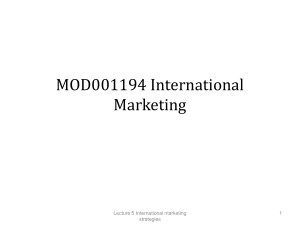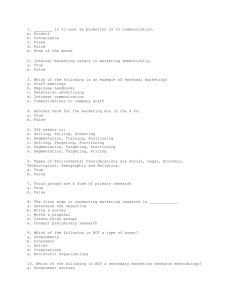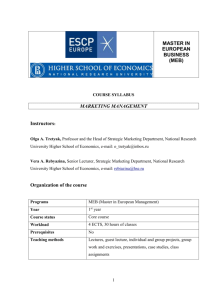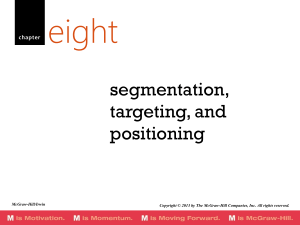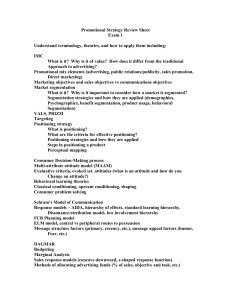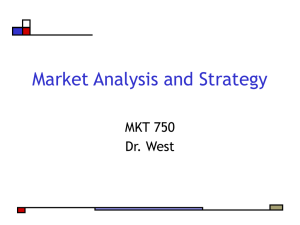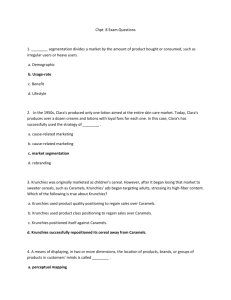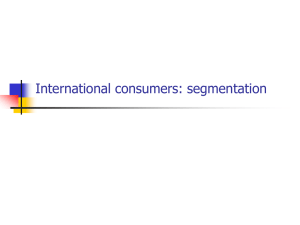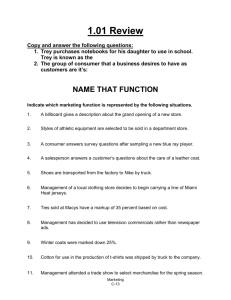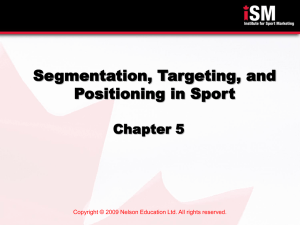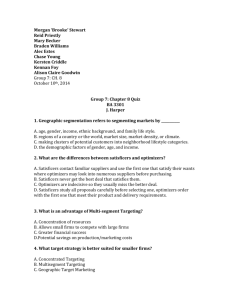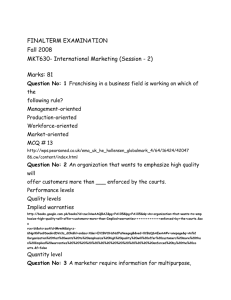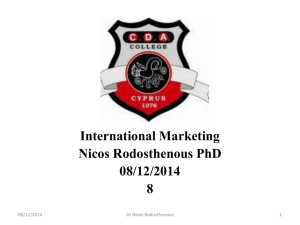1 - International University, Sofia
advertisement
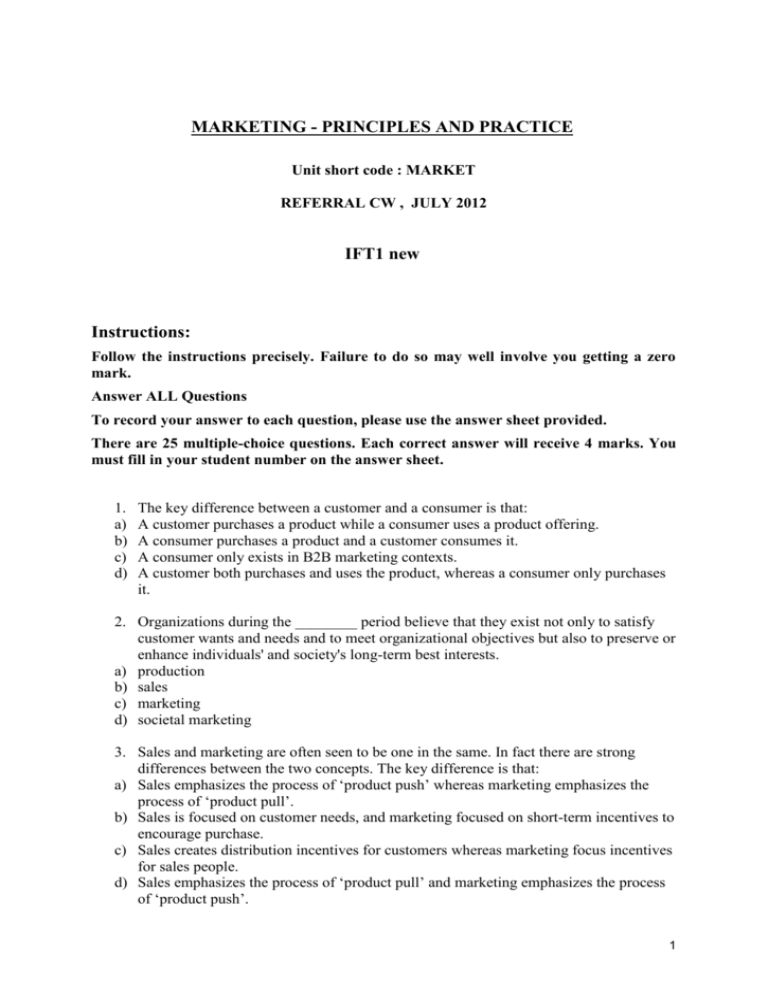
MARKETING - PRINCIPLES AND PRACTICE Unit short code : MARKET REFERRAL CW , JULY 2012 IFT1 new Instructions: Follow the instructions precisely. Failure to do so may well involve you getting a zero mark. Answer ALL Questions To record your answer to each question, please use the answer sheet provided. There are 25 multiple-choice questions. Each correct answer will receive 4 marks. You must fill in your student number on the answer sheet. 1. a) b) c) d) The key difference between a customer and a consumer is that: A customer purchases a product while a consumer uses a product offering. A consumer purchases a product and a customer consumes it. A consumer only exists in B2B marketing contexts. A customer both purchases and uses the product, whereas a consumer only purchases it. 2. Organizations during the ________ period believe that they exist not only to satisfy customer wants and needs and to meet organizational objectives but also to preserve or enhance individuals' and society's long-term best interests. a) production b) sales c) marketing d) societal marketing 3. Sales and marketing are often seen to be one in the same. In fact there are strong differences between the two concepts. The key difference is that: a) Sales emphasizes the process of ‘product push’ whereas marketing emphasizes the process of ‘product pull’. b) Sales is focused on customer needs, and marketing focused on short-term incentives to encourage purchase. c) Sales creates distribution incentives for customers whereas marketing focus incentives for sales people. d) Sales emphasizes the process of ‘product pull’ and marketing emphasizes the process of ‘product push’. 1 4. In order to make sense of the external environment we use a framework known as PESTLE. PESTLE stands for the: a) Production, Economic, Social, Technological, Legal, and Ecological environments. b) Political, Economic, Social, Technological, Legal, and Ecological environments. c) Political, Economic, Systematic, Territorial, Legal, and Ecological environments. d) Psychological, Economic, Sociological, Technological, Lifestyle, and Ecological environments. 5. The_____________ consists of those organizations that either directly or indirectly influence an organization’s operational performance. a) external environment b) performance environment c) internal environment d) environmental scanning 6. A female consumer decides that she needs to buy a new dress for a party, because she’s grown tired of the old one, or because she thinks it’s out of fashion, or to cheer herself up, or for a special occasion. This is an example of which stage in the consumer product acquisition process? a) Information gathering b) Motive development c) Product selection d) Product acquisition 7. These are beliefs of a social group or individual which are held with some conviction, often learned from parents and formed early in life, and tend to change less and less with age, which define how we ought to behave. a) Attitudes b) Opinions c) Values d) Motives 8. a) b) c) d) Marketing research has three research designs. These are: normative, descriptive and explanatory predictive, normative and persuasive explorative, descriptive and causal flexible, interactive and discovery-oriented 9. a) b) c) d) The basic characteristic of a probability sample is that: Every individual in the relevant universe has an equal chance of being selected. There is a chance of any member of the population being selected. All possible members of the population have provided information. 100 per cent of all subgroups have been handpicked. 10. These firms select small segments within target market that the larger companies do not want to exploit. Which type of market position does this refer to? a) Market leaders b) Market challengers c) Market nichers d) Market followers 2 11. When devising a marketing plan, this activity involves expressing the desired outcomes of the strategy as expressed in terms of the volume of expected sales, the value of sales and market share gains, levels of product awareness, availability, profitability and customer satisfaction. a) Marketing goals b) Marketing strategies c) Marketing analysis d) Implementation 12. The method by which whole markets are subdivided into different segments is referred to as the STP process. STP stands for: a) Segmentation, Testing and Positioning b) Selectivity, Targeting and Positioning c) Segmentation, Targeting and Perception d) Segmentation, Targeting and Positioning 13. To segment consumer good and service markets we use market information we have collected classified as segmentation bases. These bases include profile, behavioural and psychological criteria. Examples of profile criteria include: a) gender, age, occupation, life stage and benefits sought criteria b) media usage, transaction history, age and geo-graphics. c) demographic, lifestage, geographic and geo-demographic criteria d) occupation, income, product usage and lifestyle (psychographics). 14. This term describes a stage in the new product development process, undertaken when a new product is tested with a sample of customers, or is launched in a specified geographical area to judge customers' reactions prior to a national launch. a) Adoption process b) Product lifecycle c) Process of diffusion d) Test marketing 15. This type of branding was once referred to as a multi-brand policy, and requires that each product offered by an organization is branded independently of all the others. a) Individual branding b) Family banding c) Corporate brands d) Licensed brands 3 16. Marketing communications is a relatively new term for what was previously referred to as: a) promotion b) advertising c) public relations d) word of mouth 17. People who exert personal influence because of their profession, authority, education or status associated with the object of the communication process are: a) opinion creators b) opinion seekers c) opinion leader d) opinion formers 18. This is a form of interpersonal communication about products or services where a receiver regards the communicator as somebody who is impartial and who is not attempting to sell products or services. a) Personal selling b) Word of mouth c) Customer service d) Direct marketing 19. This is the combination of five key communications tools; advertising, sales promotions, public relations, direct marketing and personal selling. a) Marketing communications mix b) Service mix c) Pricing mix d) Media mix 20. In 2008, O2 introduced its ‘Scrum in the Park’ event. This allowed rugby fans the opportunity to meet the team and even test their skills. This is an example of: a) Sales promotion b) Sponsorship c) Personal selling d) Direct marketing 4 21. An identified sponsor uses the internet to persuade or influence audiences to pass along the content, e.g. picture, game or a joke to their peers at no cost. This is referred to as: a) word of mouth b) personal selling c) viral marketing d) spam 22. Services are characterized by five distinct characteristics. Which of the following is not one of these characteristics: a) Inseparability b) Tangibility c) Perishability d) Variability 23. Which of the following is not one of the additional ‘P’s’ that have been included in order to meet the express needs of the service context? a) Promotion b) People c) Physical evidence d) People 24. When making a buying decision about a product the organization has purchased before, if an organization decides that it needs to change the specification of the product, further negotiate on price levels with the supplier, or perhaps make an arrangement for alternative delivery patterns, this is an example of which type of buying decision? a) New task b) Straight rebuy c) Switch buy d) Modified rebuy 25. In the organizational decision-making process, these are people who help set the technical specifications for a proposed purchase and assist the evaluation of alternative offerings by potential suppliers. a) Influencers b) Deciders c) Gatekeepers d) Users 5
